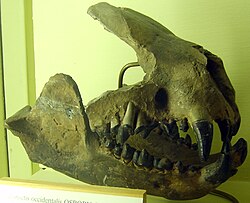Oxyaenidae
| Oxyaenidae Temporal range: Middle Paleocene to late Eocene 60.2–33.9 Ma |
|
|---|---|
 |
|
| Part of a Palaeonictis occidentalis skull at the Museum für Naturkunde, Berlin | |
| Scientific classification | |
| Kingdom: | Animalia |
| Phylum: | Chordata |
| Class: | Mammalia |
| Superorder: | Laurasiatheria |
| Order: | Creodonta |
| Family: |
†Oxyaenidae Cope, 1877 |
| Subfamilies | |
†Ambloctoninae
†Oxyaeninae
†Tytthaeninae
†Machaeroidinae
Oxyaenidae is a family of carnivorous mammals. Traditionally classified in Creodonta, this group may be related to pangolins. The group contains four subfamilies comprising thirteen genera.
North American oxyaenids were the first creodonts to appear during the late Paleocene, while smaller radiations of oxyaenids in Europe and Asia occurred during the Eocene. They were superficially cat-like beasts that walked on flat feet, in contrast to modern cats, which walk or run on their toes. Anatomically, characteristic features include a short, broad skull, deep jaws, and teeth designed for crushing rather than shearing, as in the hyaenodonts or modern cats.(Lambert, 163)
Oxyaenids were specialized carnivores that preyed on other terrestrial vertebrates, eggs and insects. They were capable of climbing trees, which is suggested by fossil evidence of their paws.
...
Wikipedia
